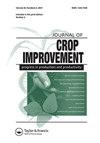简单的直接DNA提取方案,通过常规PCR高效常规检测植物致病菌
IF 1.5
Q3 AGRONOMY
引用次数: 0
摘要
快速、简便和直接的DNA提取方案需要用于常规分析中检测植物致病菌。为此,优化了5种不使用苯酚和氯仿等有毒化学物质的细菌DNA提取方法,利用传统的聚合酶链反应(PCR)快速、直接地从植物材料中检测植物致病菌。该方案是基于使用不同的浸渍和提取缓冲液,以确保高质量的细菌DNA提取和去除PCR抑制剂。结果表明,基于Tris和TNPEE缓冲液的方案1和基于0.4%牛血清白蛋白和0.05% Tween 20的方案3能够从苹果和梨样品中检测到淀粉状欧文氏菌。在浸渍和提取缓冲液中使用2%聚乙烯吡咯烷酮的方案#2被发现对直接从植物组织中检测淀粉状埃温氏菌、肿瘤农杆菌和葡萄异根菌是有效的。然而,分别使用1% Triton X-100和0.1% Tween 20的方案4和方案5无法检测到所研究的细菌。因此,提出了利用PCR技术高效、直接、快速检测植物材料中的植物致病菌的方案#2。本文章由计算机程序翻译,如有差异,请以英文原文为准。
Simple direct DNA extraction protocols for efficient routine detection of plant pathogenic bacteria via conventional PCR
ABSTRACT Rapid, easy and direct DNA extraction protocols are required for use in routine analyses to detect plant pathogenic bacteria. For this purpose, five protocols for extracting bacterial DNA, which do not use toxic chemicals such as phenol and chloroform, were optimized for the detection of plant pathogenic bacteria quickly and directly from plant material using conventional polymerase chain reaction (PCR). The protocols are based on the use of different maceration and extraction buffers to ensure quality bacterial DNA extraction and to remove the PCR inhibitors. Results showed that the protocol #1 based on the use of Tris and TNPEE buffers and protocol #3 based on the use of 0.4% bovine serum albumin and 0.05% Tween 20 were able to detect Erwinia amylovora from apple and pear samples. Protocol #2 that used 2% polyvinyl pyrrolidone in maceration and extraction buffers was found to be efficient for detecting Erwinia amylovora, Agrobacterium tumefaciens, and Allorhizobium vitis directly from plant tissues. However, protocols #4 and #5 based on the use of 1% Triton X-100 and 0.1% Tween 20, respectively, were unable to detect the studied bacteria. Accordingly, the protocol #2 is proposed for efficient, direct and rapid detection of plant pathogenic bacteria in plant materials via PCR.
求助全文
通过发布文献求助,成功后即可免费获取论文全文。
去求助
来源期刊

Journal of Crop Improvement
Multiple-
CiteScore
3.30
自引率
7.70%
发文量
42
期刊介绍:
Journal of Crop Science and Biotechnology (JCSB) is a peer-reviewed international journal published four times a year. JCSB publishes novel and advanced original research articles on topics related to the production science of field crops and resource plants, including cropping systems, sustainable agriculture, environmental change, post-harvest management, biodiversity, crop improvement, and recent advances in physiology and molecular biology. Also covered are related subjects in a wide range of sciences such as the ecological and physiological aspects of crop production and genetic, breeding, and biotechnological approaches for crop improvement.
 求助内容:
求助内容: 应助结果提醒方式:
应助结果提醒方式:


